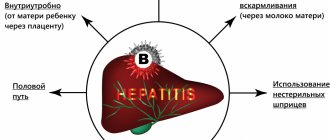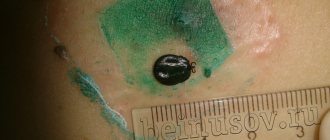Hepatitis G is transmitted in the same way as hepatitis C: through blood. This disease is widespread among drug addicts. Sexual transmission and transmission of the virus from mother to fetus is also possible.
Situations in which infection most often occurs:
- Donor blood transfusion. Worldwide, on average, 0.01-2% of donors are carriers of hepatitis viruses, so currently donor blood is tested for the presence of hepatitis viruses before transfusion to the recipient. The risk of infection increases in individuals who require repeated transfusions of blood or blood products.
- Sharing the same needle by different people increases the risk of infection many times over. This is the most common route of infection with hepatitis G today.
- Viruses can be transmitted through sexual contact, but the risk of transmitting hepatitis G virus through sexual contact is considered low.
- The route of infection from mother to child (doctors call it “vertical”). In approximately half of children born to mothers with hepatitis G virus RNA, this marker of infection can also be identified. The risk increases if the woman has an active form of the virus or suffered acute hepatitis in the last months of pregnancy. The likelihood of infection of the fetus increases sharply if the mother, in addition to the hepatitis virus, has HIV infection. The hepatitis virus is not transmitted through mother's milk.
- Hepatitis G viruses are transmitted through tattooing, acupuncture, and ear piercing with unsterile needles.
In 40% of cases, the source of infection remains unknown.
Detailed description of the study
The study is used for the qualitative determination of hepatitis G virus RNA in blood plasma using the polymerase chain reaction (PCR) method in real time with hybridization-fluorescence detection. The test is recommended for early diagnosis of viral hepatitis G (2 weeks after infection).
Hepatitis G (HGV) is an infectious disease whose causative agent belongs to the Flaviviridae family. Infection occurs parenterally from a person with hepatitis G or a carrier of the virus.
Methods of transmission of infection:
- sexual;
- vertical (from the woman to the fetus through the placenta);
- when using non-sterile medical instruments during surgical operations and dental procedures, blood transfusions or hemodialysis;
- in case of violation of the rules for sterilization of instruments in cosmetology and manicure rooms.
A high-risk group includes injection drug users.
Viral hepatitis G is often asymptomatic. The course of the disease is mild, without acute manifestations, while biochemical blood parameters remain normal.
From the moment of infection to the manifestation of the clinical picture of hepatitis G (weakness, malaise, jaundice and low-grade fever may appear) it takes from 2 to 24 weeks, at which time laboratory tests are the most informative.
Viral carriage and the chronic course of the disease are observed more often than with hepatitis B and C. At the same time, HGV is characterized by coinfection - infection simultaneously with hepatitis C, less often B and D. With coinfection, weakness and malaise become more pronounced, and jaundice appears more often.
Clinical picture
As an independent disease, hepatitis G may not have pronounced symptoms even after overcoming the incubation period, which lasts about a month. Symptoms that are nonspecific for this liver infection, such as headache, heaviness in the right hypochondrium, and even more so, jaundice with all its signs (darkening of urine and lightening of stool, yellowness of the skin and mucous membranes) are observed only when the HGV virus is combined with hepatitis C viruses , A and/or B.
If hepatitis G develops against the background of other types of this disease, intoxication accelerates, the disease takes on a lightning-fast form, and the manifestations of the icteric period rapidly increase.
A self-developing infection rarely becomes chronic and even then does not cause cirrhosis of the liver with destruction of liver tissue or primary liver cancer - hepatocarcinoma.
The icteric period with combined infection with several types of viruses of this liver infection, in addition to changes in the color of the skin, sclera and mucous membrane, urine and feces, pain in the hypochondrium, nausea and vomiting, loss of appetite, is accompanied by a significant increase in the size of the liver and spleen.
The HGV virus does not cause liver dysfunction during infection, as is observed with other viral infections that affect the hematopoietic organ.
Despite the mild course of the disease, it is dangerous due to its long period of carriage, during which a person becomes a source of infection, which neither he himself nor those around him know. Hepatitis G is dangerous due to secondary infection of the liver with other viral infections, including oncogenic ones, transition to a chronic form, which often leads to cirrhosis of the liver. In this regard, you should not self-medicate, and at the first symptoms of illness, seek qualified medical help. This is especially true for people who are at risk due to their work activities or lifestyle. Lifestyle means not only bad habits and addictions, but also donation, regular visits to beauty salons or tattoos, etc.
In the infectious and gastroenterological departments of the multidisciplinary network of clinics NEARMEDIC, highly qualified gastroenterologists, hepatologists and infectious disease specialists, including those with scientific titles, consult. In the network’s own laboratory, they carry out analyzes of any complexity and rarity, all types of hardware examinations using the latest generation medical equipment. Patients can undergo comprehensive consultations with narrow and related specialists, diagnostic examinations, outpatient or inpatient treatment in one medical network, where they are provided with a strictly individual approach.
Sources
- Meier-Stephenson V., Badmalia MD., Mrozowich T., Lau KC., Schultz SK., Gemmill DL., Osiowy C., van Marle G., Coffin CS., Patel TR. Identification and characterization of a G-quadruplex structure in the pre-core promoter region of hepatitis B virus covalently closed circular DNA. // J Biol Chem - 2021 - Vol - NNULL - p.100589; PMID:33774051
- Li Y., Yan L., Wang R., Wang Q., You Z., Li B., Zhang J., Huang B., Chen Y., Li Y., Lian M., Tang R., Qiu D ., Gershwin ME., Xiao X., Miao Q., Ma X. Correction to: Serum Immunoglobulin G Levels Predict Biochemical and Histological Remission of Autoimmune Hepatitis Type 1: A Single‑Center Experience and Literature Review. // Clin Rev Allergy Immunol - 2021 - Vol - NNULL - p.; PMID:33666868
- Thevenot T., Desmarets M. G-CSF, a ray of sunshine in the darkness for patients with alcoholic hepatitis? // Clin Res Hepatol Gastroenterol - 2021 - Vol45 - N2 - p.101585; PMID:33607376
- Li Y., Yan L., Wang R., Wang Q., You Z., Li B., Zhang J., Huang B., Chen Y., Li Y., Lian M., Tang R., Qiu D ., Gershwin ME., Xiao X., Miao Q., Ma X. Serum Immunoglobulin G Levels Predict Biochemical and Histological Remission of Autoimmune Hepatitis Type 1: A Single-Center Experience and Literature Review. // Clin Rev Allergy Immunol - 2021 - Vol - NNULL - p.; PMID:33512642
- Ito K., Okumura A., S Takeuchi J., Watashi K., Inoue R., Yamauchi T., Sakamoto K., Yamashita Y., Iguchi Y., Une M., Wakita T., Umezawa K., Yoneda M. Dual Agonist of Farnesoid X Receptor and G Protein-coupled Receptor TGR5 Inhibits Hepatitis B Virus Infection in Vitro and in Vivo. // Hepatology - 2021 - Vol - NNULL - p.; PMID:33434356
- Han T.T., Huang J.H., Gu J., Xie Q.D., Zhong Y., Huang T.H. Hepatitis B virus surface protein induces sperm dysfunction through the activation of a Bcl2/Bax signaling cascade triggering AIF/Endo G-mediated apoptosis. // Andrology - 2021 - Vol - NNULL - p.; PMID:33382193
- Wan L., Guo L., Hu Y., Huang H., Zhang M., Xu K., De G., Zheng F., Wu Z., Hu C., Wen Z. Comparing the diagnostic value of serum oligosaccharide chain (G-test) and alpha-fetoprotein for hepatitis B virus-related liver cancer. // Clin Biochem - 2021 - Vol89 - NNULL - p.44-50; PMID:33309517
- Clemente MG., Mauceri C., Grandi N., Marescalco S., Arras M., Bitti A., Galleri G., Manetti R., Schwarz K., Piana A., Castiglia P., Antonucci R. No Hepatitis G virus co-infection in migrants with Hepatitis B or C hosted in Sardinia and Sicily. // Clin Res Hepatol Gastroenterol - 2021 - Vol - NNULL - p.101566; PMID:33234432
- Wolf JM., De Carli S., Pereira VRZB., Simon D., Lunge VR. Temporal evolution and global spread of hepatitis B virus genotype G. // J Viral Hepat - 2021 - Vol28 - N2 - p.393-399; PMID:33128240
- Bergløv A., Hallager S., Panum I., Weis N. Prevalence of herpes -, measles morbillivirus-, parvovirus B19 - and rubella viruses immunoglobulin G among women with chronic hepatitis B of reproductive age in Denmark: A cross-sectional study. // Int J Infect Dis - 2021 - Vol101 - NNULL - p.269-275; PMID:33011282
Disease prognosis
The last resort in treatment is a liver transplant.
There is no exact information yet about how dangerous hepatitis G is for the liver and for health in general. Based on the studies conducted, it can be concluded that infected patients can develop lymphoma. This is the name of cancer of the lymphatic system, which is almost impossible to cure.
If you do not pay attention to the progressive disease, cirrhosis will develop.
How dangerous is hepatitis G during pregnancy?
As for the vertical mode of transmission of the pathogen, research is under study. According to statistics, 35-55% of infants born to HGV-positive mothers were infected. The maximum risk of infection is observed during the period when a pregnant woman experiences the acute stage of hepatitis.
Babies delivered by caesarean section have a lower risk of infection compared to babies born vaginally. In the latter case, even with a negative result for HGV in the first days of life, the virus can subsequently be detected in the child’s blood. All this indicates a high risk of intrauterine infection, as well as the possibility of transmission of the pathogen during labor.
During lactation, infection does not occur.
Possible complications
In most cases, no serious complications of the disease are observed. There are several forms of hepatitis:
- typical, characterized by a slow onset of clinical symptoms and a slight change in laboratory parameters. Jaundice may be mild or absent altogether;
- fulminant is characterized by rapid deterioration of the condition, severe jaundice and a sharp change in laboratory indicators of liver function.
Often, the latter form develops with combined damage to the gland by viruses of types B or C. In this case, the risk of developing:
- cirrhosis, when normal organ tissue is replaced by connective tissue, as a result of which liver functions suffer;
- portal hypertension, in which the pressure in the venous system increases, which is manifested by varicose veins of the esophagus, ascites and the appearance of veins on the abdomen;
- bleeding as complications of cirrhosis;
- malignant process, when cells change their structure and form a tumor focus;
- cholestasis (stagnation of bile) when the excretory ducts are blocked.
Preventive measures
To avoid contracting hepatitis, it is important to avoid direct contact with blood and always wear gloves. It is also necessary to use your own personal hygiene products and think about the rules of safe sex. It is important to get proper rest, get enough sleep, maintain a healthy lifestyle and normal physical activity.
Articles about other types of hepatitis:
- About hepatitis A
- About hepatitis B (B)
- About hepatitis D (D)
Treatment options
Treatment of hepatitis G requires mandatory observation by the attending physician in a hospital or in medical centers. Regular blood tests are also important. In addition, it is very important to maintain bed rest. It helps internal organs recover faster and speed up recovery. Oxygen treatment may also be prescribed, but this is done only in exceptional cases.
Medicines are used to treat chronic viral infections. They stop further liver damage and destroy the virus. In the presence of hepatitis C and B, therapy for these diseases is prescribed.
Which doctors should I contact?
Treatment with medications and diet should begin as early as possible
If signs of hepatitis G appear, you should consult a physician and virologist.
What medications are prescribed?
To reduce liver inflammation and prevent the development of cirrhosis, it is important to begin treatment for this disease in a timely manner. As a result, the virus can be completely or partially removed from the body.
The drug Alpha Interferon can be used in any treatment for hepatitis B. As a result, new liver cells are not infected. The transformation of the disease into liver cancer also becomes almost impossible. If the drug is used together with Ribavirin, the effect of this treatment will be much better.
Surgical methods of treatment
In medical centers for hepatitis G, liver transplantation can be performed. This form of hepatitis leads to high mortality if the damaged organ is not transplanted.
Ethnoscience:
- blue plum cuttings with buds are used to treat hepatitis. In the Urals and Siberian region, raspberries with cuttings and buds are ideal for this. Crushed cuttings are poured with boiling water and taken orally before meals for a month. After 3 months, the treatment is repeated. You need to drink infusions every year until the patient is cured. At this time, you should also drink vegetable juices, rosehip drinks, and take fish oil;
- Chanterelle mushroom powder is poured with vodka and left for 10 days. The container must be shaken daily. Take the drug for about 4 months.
Diet
Adjusting nutrition allows you to reduce the load on the diseased organ and effectively supports the body. Moreover, it is prescribed individually to each patient. It is important to completely stop drinking alcohol, coffee, and reduce the consumption of salt, fatty and spicy foods. You need to eat more fermented milk products, vegetables, cereals, fruits, and lean meats.
It is recommended to steam or boil foods. Milk should not be consumed, but it can be used to prepare various dishes and sauces. Pastila and marshmallows can be consumed as dessert. You need to drink more water, compotes, tea or jelly. Split meals help with this disease.
An important component of effective treatment is proper nutrition.









